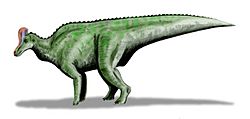Velafrons facts for kids
Quick facts for kids VelafronsTemporal range: Upper Cretaceous
|
|
|---|---|
 |
|
| Scientific classification | |
| Kingdom: | |
| Phylum: | |
| Class: | |
| Superorder: | |
| Order: | |
| Family: | |
| Subfamily: | |
| Genus: |
Velafrons
Gates et al., 2007
|
| Species | |
|
|
Velafrons (say "VAY-la-frons") means "sailed forehead." This cool name comes from the shape of its head! It was a type of dinosaur called a hadrosaurid, also known as a "duck-billed dinosaur." Velafrons lived during the Upper Cretaceous period, about 73.5 million years ago, in what is now Mexico.
Contents
Discovering Velafrons
The first fossils of Velafrons were found in the Cerro del Pueblo Formation. This rock layer is about 73.5 million years old. The discovery happened near a place called Rincon Colorado in Coahuila, Mexico. The main fossil, known as the "type specimen," is called CPC-59. The official name for this dinosaur is Velafrons coahuilensis.
What is a Type Specimen?
When scientists find a new animal or plant, they choose one special fossil or sample. This is called the "type specimen." It acts like the official example for that species. Any new fossils found later are compared to this type specimen to see if they belong to the same group.
What is a Type Species?
Just like a type specimen for an individual, a "type species" is the main species that defines a whole group of animals (a genus). For Velafrons, V. coahuilensis is the type species. This means it's the most important example that helps scientists understand all dinosaurs in the Velafrons genus.
A Look at Hadrosaurids
Velafrons was a hadrosaurid dinosaur. These dinosaurs are famous for their unique "duck-billed" snouts. They were plant-eaters (herbivores) and lived in large herds. Hadrosaurids are divided into two main groups:
- Hadrosaurinae: These had flat, solid skulls.
- Lambeosaurinae: These had hollow crests on their heads. Velafrons belongs to this group!
The Crest of Velafrons
The "sailed forehead" name for Velafrons comes from its special head crest. This crest was likely used for different things:
- Making Sounds: The hollow crest might have helped them make loud calls. These calls could have been used to talk to other dinosaurs in their herd or to warn about danger.
- Looking Unique: The crest also made each Velafrons look different. This could have helped them recognize each other, especially during mating season.
Where it Lived: Ancient Mexico
During the Upper Cretaceous period, the area where Velafrons lived in Mexico was very different from today. It was a warm, humid place with lots of plants. This environment was perfect for large plant-eating dinosaurs like Velafrons. They would have grazed on ferns, conifers, and other plants.
Images for kids
See also
 In Spanish: Velafrons coahuilensis para niños
In Spanish: Velafrons coahuilensis para niños


